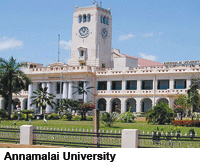A spate of media reports highlighting that the 83-year-old unitary Annamalai University (AU, estb. 1929) sited in Chidambaram, is reeling under a severe financial crisis has taken the academic community in the southern seaboard state of Tamil Nadu — and Chennai in particular — by shock and surprise. There is bewilderment within academia and the intelligentsia over why an 83-year-old well-established, state-aided university is heading towards bankruptcy while several private varsities in the state are flourishing.
 Established in 1929 by legendary philanthropist Annamalai Chettiar, AU has 30,000 students enroled in its arts, science, engineering, education and medical degree programmes and another 450,000 students who have signed up for its distance education courses. Together they pay Rs.409 crore as annual tuition fees. Moreover, as an aided varsity, AU receives an annual state government grant of Rs.61 crore and an additional Rs.13 crore from the Delhi-based University Grants Commission. Against this, the university’s annual salary bill for its 3,896 faculty and 9,434 non-teaching staff adds up to Rs.37 crore per month or Rs.444 crore annually. Confronted with annual deficits ranging from Rs.48-155 crore (2011-12) for the past 13 years, push came to shove on November 7 when vice chancellor M. Ramanathan proposed to retrench some staff and ordered a 50 percent salary cut for others to tide over the crisis.
Established in 1929 by legendary philanthropist Annamalai Chettiar, AU has 30,000 students enroled in its arts, science, engineering, education and medical degree programmes and another 450,000 students who have signed up for its distance education courses. Together they pay Rs.409 crore as annual tuition fees. Moreover, as an aided varsity, AU receives an annual state government grant of Rs.61 crore and an additional Rs.13 crore from the Delhi-based University Grants Commission. Against this, the university’s annual salary bill for its 3,896 faculty and 9,434 non-teaching staff adds up to Rs.37 crore per month or Rs.444 crore annually. Confronted with annual deficits ranging from Rs.48-155 crore (2011-12) for the past 13 years, push came to shove on November 7 when vice chancellor M. Ramanathan proposed to retrench some staff and ordered a 50 percent salary cut for others to tide over the crisis.
Following announcement of this intent, bedlam broke out at the university with several employee unions forming a joint action council (JAC) and threatening to strike work from November 15 if the management didn’t reverse its decision. The JAC urged the state government to resolve the issue and called off its protest only after the AU registrar issued a circular assuring employees that the management won’t retrench staff or impose pay cuts.
The JAC holds the au management responsible for the grave financial crisis which confronts this 83-year-old varsity. According to them, despite the Chettiar family not having made any investment in AU since 1929 when Rajah Sir S.R.M. Annamalai Chettiar donated 200 acres of land and Rs.20 lakh to establish the university, a member of the promoter family “as a token of respect’’ has always held the post of pro-chancellor. Currently, M.A.M. Ramasami is pro-chancellor of AU.
“The hereditary pro-chancellor wields great power in AU. Unlike other state universities, the pro-chancellor of AU has the right to nominate three candidates for the post of vice chancellor with the chancellor (the governor of Tamil Nadu ex-officio) obliged to appoint one of them. With the hand-picked vice chancellor heading academics and the pro-chancellor heading administration, together they control the university and all faculty and employees recruitment. This has led to nepotism and massive over-recruitment,’’ says K. Mathialagan, joint convener of JAC. According to R. Udaichandran, convener of JAC, although AU’s government-sanctioned faculty and non-faculty strength is 860 and 1,820, these numbers have risen to 3,896 and 9,434 respectively — an excess of over 10,000 personnel.
However, according to the management, the fast-track expansion of AU over the past 15 years — the number of distance education students has increased from 4,000 in 1990 to over 450,000 currently — has necessitated additional staff recruitment. “The salary bill of AU faculty has increased by 30 percent and non-teaching staff by 20 percent after implementation of the Sixth Pay Commission recommendations which became effective retrospectively from January 2006. Moreover, dearness allowance has tripled and so have retirement benefits. The state government doesn’t pay faculty salaries after 1996 which the varsity has to bear,” counters M. Ramanathan, vice chancellor.
However in the slanging match between the AU management and JAC, the unseen elephant in the room is the issue of rock-bottom tuition fees which average a mere Rs.8,520 per student per year. With the state government which sets tuition fees too timorous to raise them to reasonable levels — “too politically sensitive an issue’’ — this vintage university lumbered with a hybrid administrative structure, is rapidly rolling downhill.
Hemalatha Raghupathi (Chennai)


























